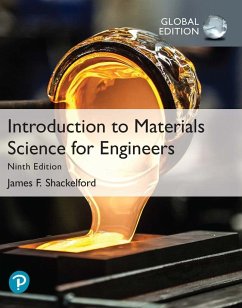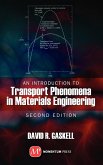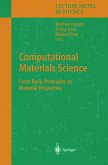James Shackelford, James F. Shackelford
Introduction to Materials Science for Engineers, Global Edition
James Shackelford, James F. Shackelford
Introduction to Materials Science for Engineers, Global Edition
- Broschiertes Buch
- Merkliste
- Auf die Merkliste
- Bewerten Bewerten
- Teilen
- Produkt teilen
- Produkterinnerung
- Produkterinnerung
For a first course in Materials Sciences and Engineering taught in the departments of materials science, mechanical, civil and general engineering. Introduction to Materials Science for Engineers provides balanced, current treatment of the full spectrum of engineering materials, covering all the physical properties, applications and relevant properties associated with engineering materials. It explores all of the major categories of materials while also offering detailed examinations of a wide range of new materials with high-tech applications. Revised to reflect recent data and trends, the…mehr
Andere Kunden interessierten sich auch für
![An Introduction to Transport Phenomena In Materials Engineering, 2nd edition An Introduction to Transport Phenomena In Materials Engineering, 2nd edition]() David GaskellAn Introduction to Transport Phenomena In Materials Engineering, 2nd edition165,99 €
David GaskellAn Introduction to Transport Phenomena In Materials Engineering, 2nd edition165,99 €![The Science and Engineering of Materials, Enhanced Edition The Science and Engineering of Materials, Enhanced Edition]() Wendelin WrightThe Science and Engineering of Materials, Enhanced Edition374,99 €
Wendelin WrightThe Science and Engineering of Materials, Enhanced Edition374,99 €![Computational Materials Science Computational Materials Science]() Wolfram Hergert / Arthur Ernst / Markus Däne (eds.)Computational Materials Science77,99 €
Wolfram Hergert / Arthur Ernst / Markus Däne (eds.)Computational Materials Science77,99 €![Undergraduate Introduction to Financial Mathematics, an (Second Edition) Undergraduate Introduction to Financial Mathematics, an (Second Edition)]() J Robert BuchananUndergraduate Introduction to Financial Mathematics, an (Second Edition)73,99 €
J Robert BuchananUndergraduate Introduction to Financial Mathematics, an (Second Edition)73,99 €![Disordered Semiconductors Second Edition Disordered Semiconductors Second Edition]() Disordered Semiconductors Second Edition197,99 €
Disordered Semiconductors Second Edition197,99 €![Internal Combustion Engines: a Reference Book for Designers, Operators, Engineers, and Students Internal Combustion Engines: a Reference Book for Designers, Operators, Engineers, and Students]() William Manville HogleInternal Combustion Engines: a Reference Book for Designers, Operators, Engineers, and Students37,99 €
William Manville HogleInternal Combustion Engines: a Reference Book for Designers, Operators, Engineers, and Students37,99 €![Oscilloscopes: A Manual for Students, Engineers, and Scientists Oscilloscopes: A Manual for Students, Engineers, and Scientists]() David HerresOscilloscopes: A Manual for Students, Engineers, and Scientists29,99 €
David HerresOscilloscopes: A Manual for Students, Engineers, and Scientists29,99 €-
-
-
For a first course in Materials Sciences and Engineering taught in the departments of materials science, mechanical, civil and general engineering. Introduction to Materials Science for Engineers provides balanced, current treatment of the full spectrum of engineering materials, covering all the physical properties, applications and relevant properties associated with engineering materials. It explores all of the major categories of materials while also offering detailed examinations of a wide range of new materials with high-tech applications. Revised to reflect recent data and trends, the 9th Edition includes updated computer-generated crystal structure illustrations and new end-of-chapter conceptual problems.
Hinweis: Dieser Artikel kann nur an eine deutsche Lieferadresse ausgeliefert werden.
Hinweis: Dieser Artikel kann nur an eine deutsche Lieferadresse ausgeliefert werden.
Produktdetails
- Produktdetails
- Verlag: Pearson / Pearson Education Limited
- 9. Auflage
- Seitenzahl: 704
- Erscheinungstermin: 14. November 2022
- Englisch
- Abmessung: 253mm x 204mm x 26mm
- Gewicht: 1274g
- ISBN-13: 9781292440996
- ISBN-10: 1292440996
- Artikelnr.: 63508031
- Herstellerkennzeichnung
- Pearson
- St.-Martin-Straße 82
- 81541 München
- salesde@pearson.com
- +4989541960460
- Verlag: Pearson / Pearson Education Limited
- 9. Auflage
- Seitenzahl: 704
- Erscheinungstermin: 14. November 2022
- Englisch
- Abmessung: 253mm x 204mm x 26mm
- Gewicht: 1274g
- ISBN-13: 9781292440996
- ISBN-10: 1292440996
- Artikelnr.: 63508031
- Herstellerkennzeichnung
- Pearson
- St.-Martin-Straße 82
- 81541 München
- salesde@pearson.com
- +4989541960460
James F. Shackelford has BS and MS degrees in Ceramic Engineering from the University of Washington and a Ph.D. in Materials Science and Engineering from the University of California, Berkeley. Following a postdoctoral fellowship at McMaster University in Canada, he joined the University of California, Davis, where he is currently Distinguished Professor Emeritus in the Department of Materials Science and Engineering. For many years, he served as the Associate Dean for Undergraduate Studies in the College of Engineering and later as the Director of the University Honors Program that serves students from a wide spectrum of majors. Dr. Shackelford also served as Associate Director for Education for the National Science Foundation (NSF)-funded Center for Biophotonics Science and Technology (CBST) and as Faculty Assistant to the Director of the McClellan Nuclear Research Center (MNRC) of UC Davis. He teaches and conducts research in the structural characterization and processing of materials, focusing on glasses and biomaterials. His current focus in teaching is doing so through online technologies. A member of the American Ceramic Society and ASM International, he was named a Fellow of the American Ceramic Society in 1992, was named a Fellow of ASM International in2011, and received the Outstanding Educator Award of the American Ceramic Society in 1996 and the Albert Easton White Distinguished Teacher Award from ASM International in 2019. In 2003, he received a Distinguished Teaching Award from the Academic Senate of the University of California, Davis. In 2012, he received the Outstanding Teaching Award of the College of Engineering at UC Davis, and, in 2014, received an Outstanding Service Award from UC Davis Extension. In 2016, Professor Shackelford received the Inaugural Award for Outstanding Contributions to Materials Education at the North American Materials Education Symposium (NAMES) held at the University of California, Berkeley. He has published over 150 archived papers and books including Introduction to Materials Science for Engineers now in its 9th Edition and which has been translated into Chinese, German, Italian, Japanese, Korean, Portuguese, and Spanish.
1. Materials for Engineering
2. 1.1 The Material World
3. 1.2 Materials Science and Engineering
4. 1.3 Six Materials That Changed Your World
o STEEL BRIDGESINTRODUCING METALS
o TRANSPARENT OXIDESINTRODUCING CERAMICS
o SMARTPHONES AND TABLETSINTRODUCING GLASSES
o NYLON PARACHUTESINTRODUCING POLYMERS
o KEVLAR®-REINFORCED TIRESINTRODUCINGCOMPOSITES
o SILICON CHIPSINTRODUCING SEMICONDUCTORS
5. 1.4 Processing and Selecting Materials
6. 1.5 Looking at Materials by Powers of Ten
PARTI: The Fundamentals
1. Atomic Bonding
* 2.1 Atomic Structure
* 2.2 The Ionic Bond
* COORDINATION NUMBER
* 2.3 The Covalent Bond
* 2.4 The Metallic Bond
* 2.5 The Secondary, or van der Waals, Bond
* 2.6 MaterialsThe Bonding Classification
2. Crystalline StructurePerfection
* 3.1 Seven Systems and Fourteen Lattices
* 3.2 Metal Structures
* 3.3 Ceramic Structures
3. Crystal Defects and Noncrystalline StructureImperfection
* 4.1 The Solid SolutionChemical Imperfection
* 4.2 Point DefectsZero-Dimensional Imperfections
* 4.3 Linear Defects, or DislocationsOne-Dimensional Imperfections
* 4.4 Planar DefectsTwo-Dimensional Imperfections
* 4.5 Noncrystalline SolidsThree-Dimensional Imperfections
4. Diffusion
* 5.1 Thermally Activated Processes
* 5.2 Thermal Production of Point Defects
* 5.3 Point Defects and Solid-State Diffusion
* 5.4 Steady-State Diffusion
* 5.5 Alternate Diffusion Paths
5. Mechanical Behavior
* 6.1 Stress Versus Strain
* METALS
* CERAMICS AND GLASSES
* POLYMERS
* 6.2 Elastic Deformation
* 6.3 Plastic Deformation
* 6.4 Hardness
* 6.5 Creep and Stress Relaxation
* 6.6 Viscoelastic Deformation
* INORGANIC GLASSES
* ORGANIC POLYMERS
* ELASTOMERS
6. Thermal Behavior
* 7.1 Heat Capacity
* 7.2 Thermal Expansion
* 7.3 Thermal Conductivity
* 7.4 Thermal Shock
7. Failure Analysis and Prevention
* 8.1 Impact Energy
* 8.2 Fracture Toughness
* 8.3 Fatigue
* 8.4 Nondestructive Testing
* 8.5 Failure Analysis and Prevention
8. Phase DiagramsEquilibrium Microstructural Development
* 9.1 The Phase Rule
* 9.2 The Phase Diagram
* COMPLETE SOLID SOLUTION EUTECTIC DIAGRAM WITH NO SOLID SOLUTION
* EUTECTIC DIAGRAM WITH LIMITED SOLID SOLUTION
* EUTECTOID DIAGRAM
* PERITECTIC DIAGRAM
* GENERAL BINARY DIAGRAMS
* 9.3 The Lever Rule
* 9.4 Microstructural Development During Slow Cooling
9. TimeThe Third Dimension
* 10.1 TimeThe Third Dimension
* 10.2 The TTT Diagram
* DIFFUSIONAL TRANSFORMATIONS
* DIFFUSIONLESS (MARTENSITIC) TRANSFORMATIONS
* HEAT TREATMENT OF STEEL
* 10.3 Hardenability
* 10.4 Precipitation Hardening
* 10.5 Annealing
* COLD WORK
* RECOVERY
* RECRYSTALLIZATION
* GRAIN GROWTH
* 10.6 The Kinetics of Phase Transformations for Nonmetals
PART II: Materials and Their Applications
10. Structural MaterialsMetals, Ceramics, and Glasses
* 11.1 Metals
* FERROUS ALLOYS
* NONFERROUS ALLOYS
* 11.2 Ceramics and Glasses
* CERAMICSCRYSTALLINE MATERIALS
* GLASSESNONCRYSTALLINE MATERIALS
* GLASS-CERAMICS
* 11.3 Processing the Structural Materials
* PROCESSING OF METALS
* PROCESSING OF CERAMICS AND GLASSES
11. Structural MaterialsPolymers and Composites
* Polymers
* POLYMERIZATION
* STRUCTURAL FEATURES OF POLYMERS
* THERMOPLASTIC POLYMERS
* THERMOSETTING POLYMERS
* ADDITIVES
* 12.2 Composites
* FIBER-REINFORCED COMPOSITES
* AGGREGATE COMPOSITES
* PROPERTY AVERAGING
* MECHANICAL PROPERTIES OF COMPOSITES
* 12.3 Processing the Structural Materials
* PROCESSING OF POLYMERS
* PROCESSING OF COMPOSITES
12. Electronic Materials
* 13.1 Charge Carriers and Conduction
* 13.2 Energy Levels and Energy Bands
* 13.3 Conductors
* THERMOCOUPLES
* SUPERCONDUCTORS
* 13.4 Insulators
* FERROELECTRICS
* PIEZOELECTRICS
* 13.5 Semiconductors
* INTRINSIC, ELEMENTAL SEMICONDUCTORS
* EXTRINSIC, ELEMENTAL SEMICONDUCTORS
* COMPOUND SEMICONDUCTORS
* PROCESSING OF SEMICONDUCTORS
* SEMICONDUCTOR DEVICES
* 13.6 Composites
* 13.7 Electrical Classification of Materials
13. Optical and Magnetic Materials
* 14.1 Optical Materials
* OPTICAL PROPERTIES
* OPTICAL SYSTEMS AND DEVICES
* 14.2 Magnetic Materials
* FERROMAGNETISM
* FERRIMAGNETISM
* METALLIC MAGNETS
* CERAMIC MAGNETS
14. Materials in Engineering Design
* 15.1 Material PropertiesEngineering Design Parameters
* 15.2 Selection of Structural MaterialsCase Studies
* MATERIALS FOR HIP- AND KNEE-JOINT REPLACEMENT
* METAL SUBSTITUTION WITH COMPOSITES
* 15.3 Selection of Electronic, Optical, and Magnetic MaterialsCase
Studies
* LIGHT-EMITTING DIODE
* GLASS FOR SMART PHONE AND TABLET TOUCHSCREENS
* AMORPHOUS METAL FOR ELECTRIC-POWERDISTRIBUTION
* 15.4 Materials and Our Environment
* ENVIRONMENTAL DEGRADATION OF MATERIALS
* ENVIRONMENTAL ASPECTS OF DESIGN RECYCLING AND REUSE
* APPENDIX1: Physical and Chemical Data for the Elements
* APPENDIX 2: Atomic and Ionic Radii of the Elements
* APPENDIX 3: Constants and Conversion Factors and the Periodic Table
of Elements
* APPENDIX 4: Properties of the Structural Materials
* APPENDIX 5: Properties of the Electronic, Optical, and Magnetic
Materials
* APPENDIX 6: Glossary Answers to Practice Problems (PP) and
Odd-Numbered Problems Index
2. 1.1 The Material World
3. 1.2 Materials Science and Engineering
4. 1.3 Six Materials That Changed Your World
o STEEL BRIDGESINTRODUCING METALS
o TRANSPARENT OXIDESINTRODUCING CERAMICS
o SMARTPHONES AND TABLETSINTRODUCING GLASSES
o NYLON PARACHUTESINTRODUCING POLYMERS
o KEVLAR®-REINFORCED TIRESINTRODUCINGCOMPOSITES
o SILICON CHIPSINTRODUCING SEMICONDUCTORS
5. 1.4 Processing and Selecting Materials
6. 1.5 Looking at Materials by Powers of Ten
PARTI: The Fundamentals
1. Atomic Bonding
* 2.1 Atomic Structure
* 2.2 The Ionic Bond
* COORDINATION NUMBER
* 2.3 The Covalent Bond
* 2.4 The Metallic Bond
* 2.5 The Secondary, or van der Waals, Bond
* 2.6 MaterialsThe Bonding Classification
2. Crystalline StructurePerfection
* 3.1 Seven Systems and Fourteen Lattices
* 3.2 Metal Structures
* 3.3 Ceramic Structures
3. Crystal Defects and Noncrystalline StructureImperfection
* 4.1 The Solid SolutionChemical Imperfection
* 4.2 Point DefectsZero-Dimensional Imperfections
* 4.3 Linear Defects, or DislocationsOne-Dimensional Imperfections
* 4.4 Planar DefectsTwo-Dimensional Imperfections
* 4.5 Noncrystalline SolidsThree-Dimensional Imperfections
4. Diffusion
* 5.1 Thermally Activated Processes
* 5.2 Thermal Production of Point Defects
* 5.3 Point Defects and Solid-State Diffusion
* 5.4 Steady-State Diffusion
* 5.5 Alternate Diffusion Paths
5. Mechanical Behavior
* 6.1 Stress Versus Strain
* METALS
* CERAMICS AND GLASSES
* POLYMERS
* 6.2 Elastic Deformation
* 6.3 Plastic Deformation
* 6.4 Hardness
* 6.5 Creep and Stress Relaxation
* 6.6 Viscoelastic Deformation
* INORGANIC GLASSES
* ORGANIC POLYMERS
* ELASTOMERS
6. Thermal Behavior
* 7.1 Heat Capacity
* 7.2 Thermal Expansion
* 7.3 Thermal Conductivity
* 7.4 Thermal Shock
7. Failure Analysis and Prevention
* 8.1 Impact Energy
* 8.2 Fracture Toughness
* 8.3 Fatigue
* 8.4 Nondestructive Testing
* 8.5 Failure Analysis and Prevention
8. Phase DiagramsEquilibrium Microstructural Development
* 9.1 The Phase Rule
* 9.2 The Phase Diagram
* COMPLETE SOLID SOLUTION EUTECTIC DIAGRAM WITH NO SOLID SOLUTION
* EUTECTIC DIAGRAM WITH LIMITED SOLID SOLUTION
* EUTECTOID DIAGRAM
* PERITECTIC DIAGRAM
* GENERAL BINARY DIAGRAMS
* 9.3 The Lever Rule
* 9.4 Microstructural Development During Slow Cooling
9. TimeThe Third Dimension
* 10.1 TimeThe Third Dimension
* 10.2 The TTT Diagram
* DIFFUSIONAL TRANSFORMATIONS
* DIFFUSIONLESS (MARTENSITIC) TRANSFORMATIONS
* HEAT TREATMENT OF STEEL
* 10.3 Hardenability
* 10.4 Precipitation Hardening
* 10.5 Annealing
* COLD WORK
* RECOVERY
* RECRYSTALLIZATION
* GRAIN GROWTH
* 10.6 The Kinetics of Phase Transformations for Nonmetals
PART II: Materials and Their Applications
10. Structural MaterialsMetals, Ceramics, and Glasses
* 11.1 Metals
* FERROUS ALLOYS
* NONFERROUS ALLOYS
* 11.2 Ceramics and Glasses
* CERAMICSCRYSTALLINE MATERIALS
* GLASSESNONCRYSTALLINE MATERIALS
* GLASS-CERAMICS
* 11.3 Processing the Structural Materials
* PROCESSING OF METALS
* PROCESSING OF CERAMICS AND GLASSES
11. Structural MaterialsPolymers and Composites
* Polymers
* POLYMERIZATION
* STRUCTURAL FEATURES OF POLYMERS
* THERMOPLASTIC POLYMERS
* THERMOSETTING POLYMERS
* ADDITIVES
* 12.2 Composites
* FIBER-REINFORCED COMPOSITES
* AGGREGATE COMPOSITES
* PROPERTY AVERAGING
* MECHANICAL PROPERTIES OF COMPOSITES
* 12.3 Processing the Structural Materials
* PROCESSING OF POLYMERS
* PROCESSING OF COMPOSITES
12. Electronic Materials
* 13.1 Charge Carriers and Conduction
* 13.2 Energy Levels and Energy Bands
* 13.3 Conductors
* THERMOCOUPLES
* SUPERCONDUCTORS
* 13.4 Insulators
* FERROELECTRICS
* PIEZOELECTRICS
* 13.5 Semiconductors
* INTRINSIC, ELEMENTAL SEMICONDUCTORS
* EXTRINSIC, ELEMENTAL SEMICONDUCTORS
* COMPOUND SEMICONDUCTORS
* PROCESSING OF SEMICONDUCTORS
* SEMICONDUCTOR DEVICES
* 13.6 Composites
* 13.7 Electrical Classification of Materials
13. Optical and Magnetic Materials
* 14.1 Optical Materials
* OPTICAL PROPERTIES
* OPTICAL SYSTEMS AND DEVICES
* 14.2 Magnetic Materials
* FERROMAGNETISM
* FERRIMAGNETISM
* METALLIC MAGNETS
* CERAMIC MAGNETS
14. Materials in Engineering Design
* 15.1 Material PropertiesEngineering Design Parameters
* 15.2 Selection of Structural MaterialsCase Studies
* MATERIALS FOR HIP- AND KNEE-JOINT REPLACEMENT
* METAL SUBSTITUTION WITH COMPOSITES
* 15.3 Selection of Electronic, Optical, and Magnetic MaterialsCase
Studies
* LIGHT-EMITTING DIODE
* GLASS FOR SMART PHONE AND TABLET TOUCHSCREENS
* AMORPHOUS METAL FOR ELECTRIC-POWERDISTRIBUTION
* 15.4 Materials and Our Environment
* ENVIRONMENTAL DEGRADATION OF MATERIALS
* ENVIRONMENTAL ASPECTS OF DESIGN RECYCLING AND REUSE
* APPENDIX1: Physical and Chemical Data for the Elements
* APPENDIX 2: Atomic and Ionic Radii of the Elements
* APPENDIX 3: Constants and Conversion Factors and the Periodic Table
of Elements
* APPENDIX 4: Properties of the Structural Materials
* APPENDIX 5: Properties of the Electronic, Optical, and Magnetic
Materials
* APPENDIX 6: Glossary Answers to Practice Problems (PP) and
Odd-Numbered Problems Index
1. Materials for Engineering
2. 1.1 The Material World
3. 1.2 Materials Science and Engineering
4. 1.3 Six Materials That Changed Your World
o STEEL BRIDGESINTRODUCING METALS
o TRANSPARENT OXIDESINTRODUCING CERAMICS
o SMARTPHONES AND TABLETSINTRODUCING GLASSES
o NYLON PARACHUTESINTRODUCING POLYMERS
o KEVLAR®-REINFORCED TIRESINTRODUCINGCOMPOSITES
o SILICON CHIPSINTRODUCING SEMICONDUCTORS
5. 1.4 Processing and Selecting Materials
6. 1.5 Looking at Materials by Powers of Ten
PARTI: The Fundamentals
1. Atomic Bonding
* 2.1 Atomic Structure
* 2.2 The Ionic Bond
* COORDINATION NUMBER
* 2.3 The Covalent Bond
* 2.4 The Metallic Bond
* 2.5 The Secondary, or van der Waals, Bond
* 2.6 MaterialsThe Bonding Classification
2. Crystalline StructurePerfection
* 3.1 Seven Systems and Fourteen Lattices
* 3.2 Metal Structures
* 3.3 Ceramic Structures
3. Crystal Defects and Noncrystalline StructureImperfection
* 4.1 The Solid SolutionChemical Imperfection
* 4.2 Point DefectsZero-Dimensional Imperfections
* 4.3 Linear Defects, or DislocationsOne-Dimensional Imperfections
* 4.4 Planar DefectsTwo-Dimensional Imperfections
* 4.5 Noncrystalline SolidsThree-Dimensional Imperfections
4. Diffusion
* 5.1 Thermally Activated Processes
* 5.2 Thermal Production of Point Defects
* 5.3 Point Defects and Solid-State Diffusion
* 5.4 Steady-State Diffusion
* 5.5 Alternate Diffusion Paths
5. Mechanical Behavior
* 6.1 Stress Versus Strain
* METALS
* CERAMICS AND GLASSES
* POLYMERS
* 6.2 Elastic Deformation
* 6.3 Plastic Deformation
* 6.4 Hardness
* 6.5 Creep and Stress Relaxation
* 6.6 Viscoelastic Deformation
* INORGANIC GLASSES
* ORGANIC POLYMERS
* ELASTOMERS
6. Thermal Behavior
* 7.1 Heat Capacity
* 7.2 Thermal Expansion
* 7.3 Thermal Conductivity
* 7.4 Thermal Shock
7. Failure Analysis and Prevention
* 8.1 Impact Energy
* 8.2 Fracture Toughness
* 8.3 Fatigue
* 8.4 Nondestructive Testing
* 8.5 Failure Analysis and Prevention
8. Phase DiagramsEquilibrium Microstructural Development
* 9.1 The Phase Rule
* 9.2 The Phase Diagram
* COMPLETE SOLID SOLUTION EUTECTIC DIAGRAM WITH NO SOLID SOLUTION
* EUTECTIC DIAGRAM WITH LIMITED SOLID SOLUTION
* EUTECTOID DIAGRAM
* PERITECTIC DIAGRAM
* GENERAL BINARY DIAGRAMS
* 9.3 The Lever Rule
* 9.4 Microstructural Development During Slow Cooling
9. TimeThe Third Dimension
* 10.1 TimeThe Third Dimension
* 10.2 The TTT Diagram
* DIFFUSIONAL TRANSFORMATIONS
* DIFFUSIONLESS (MARTENSITIC) TRANSFORMATIONS
* HEAT TREATMENT OF STEEL
* 10.3 Hardenability
* 10.4 Precipitation Hardening
* 10.5 Annealing
* COLD WORK
* RECOVERY
* RECRYSTALLIZATION
* GRAIN GROWTH
* 10.6 The Kinetics of Phase Transformations for Nonmetals
PART II: Materials and Their Applications
10. Structural MaterialsMetals, Ceramics, and Glasses
* 11.1 Metals
* FERROUS ALLOYS
* NONFERROUS ALLOYS
* 11.2 Ceramics and Glasses
* CERAMICSCRYSTALLINE MATERIALS
* GLASSESNONCRYSTALLINE MATERIALS
* GLASS-CERAMICS
* 11.3 Processing the Structural Materials
* PROCESSING OF METALS
* PROCESSING OF CERAMICS AND GLASSES
11. Structural MaterialsPolymers and Composites
* Polymers
* POLYMERIZATION
* STRUCTURAL FEATURES OF POLYMERS
* THERMOPLASTIC POLYMERS
* THERMOSETTING POLYMERS
* ADDITIVES
* 12.2 Composites
* FIBER-REINFORCED COMPOSITES
* AGGREGATE COMPOSITES
* PROPERTY AVERAGING
* MECHANICAL PROPERTIES OF COMPOSITES
* 12.3 Processing the Structural Materials
* PROCESSING OF POLYMERS
* PROCESSING OF COMPOSITES
12. Electronic Materials
* 13.1 Charge Carriers and Conduction
* 13.2 Energy Levels and Energy Bands
* 13.3 Conductors
* THERMOCOUPLES
* SUPERCONDUCTORS
* 13.4 Insulators
* FERROELECTRICS
* PIEZOELECTRICS
* 13.5 Semiconductors
* INTRINSIC, ELEMENTAL SEMICONDUCTORS
* EXTRINSIC, ELEMENTAL SEMICONDUCTORS
* COMPOUND SEMICONDUCTORS
* PROCESSING OF SEMICONDUCTORS
* SEMICONDUCTOR DEVICES
* 13.6 Composites
* 13.7 Electrical Classification of Materials
13. Optical and Magnetic Materials
* 14.1 Optical Materials
* OPTICAL PROPERTIES
* OPTICAL SYSTEMS AND DEVICES
* 14.2 Magnetic Materials
* FERROMAGNETISM
* FERRIMAGNETISM
* METALLIC MAGNETS
* CERAMIC MAGNETS
14. Materials in Engineering Design
* 15.1 Material PropertiesEngineering Design Parameters
* 15.2 Selection of Structural MaterialsCase Studies
* MATERIALS FOR HIP- AND KNEE-JOINT REPLACEMENT
* METAL SUBSTITUTION WITH COMPOSITES
* 15.3 Selection of Electronic, Optical, and Magnetic MaterialsCase
Studies
* LIGHT-EMITTING DIODE
* GLASS FOR SMART PHONE AND TABLET TOUCHSCREENS
* AMORPHOUS METAL FOR ELECTRIC-POWERDISTRIBUTION
* 15.4 Materials and Our Environment
* ENVIRONMENTAL DEGRADATION OF MATERIALS
* ENVIRONMENTAL ASPECTS OF DESIGN RECYCLING AND REUSE
* APPENDIX1: Physical and Chemical Data for the Elements
* APPENDIX 2: Atomic and Ionic Radii of the Elements
* APPENDIX 3: Constants and Conversion Factors and the Periodic Table
of Elements
* APPENDIX 4: Properties of the Structural Materials
* APPENDIX 5: Properties of the Electronic, Optical, and Magnetic
Materials
* APPENDIX 6: Glossary Answers to Practice Problems (PP) and
Odd-Numbered Problems Index
2. 1.1 The Material World
3. 1.2 Materials Science and Engineering
4. 1.3 Six Materials That Changed Your World
o STEEL BRIDGESINTRODUCING METALS
o TRANSPARENT OXIDESINTRODUCING CERAMICS
o SMARTPHONES AND TABLETSINTRODUCING GLASSES
o NYLON PARACHUTESINTRODUCING POLYMERS
o KEVLAR®-REINFORCED TIRESINTRODUCINGCOMPOSITES
o SILICON CHIPSINTRODUCING SEMICONDUCTORS
5. 1.4 Processing and Selecting Materials
6. 1.5 Looking at Materials by Powers of Ten
PARTI: The Fundamentals
1. Atomic Bonding
* 2.1 Atomic Structure
* 2.2 The Ionic Bond
* COORDINATION NUMBER
* 2.3 The Covalent Bond
* 2.4 The Metallic Bond
* 2.5 The Secondary, or van der Waals, Bond
* 2.6 MaterialsThe Bonding Classification
2. Crystalline StructurePerfection
* 3.1 Seven Systems and Fourteen Lattices
* 3.2 Metal Structures
* 3.3 Ceramic Structures
3. Crystal Defects and Noncrystalline StructureImperfection
* 4.1 The Solid SolutionChemical Imperfection
* 4.2 Point DefectsZero-Dimensional Imperfections
* 4.3 Linear Defects, or DislocationsOne-Dimensional Imperfections
* 4.4 Planar DefectsTwo-Dimensional Imperfections
* 4.5 Noncrystalline SolidsThree-Dimensional Imperfections
4. Diffusion
* 5.1 Thermally Activated Processes
* 5.2 Thermal Production of Point Defects
* 5.3 Point Defects and Solid-State Diffusion
* 5.4 Steady-State Diffusion
* 5.5 Alternate Diffusion Paths
5. Mechanical Behavior
* 6.1 Stress Versus Strain
* METALS
* CERAMICS AND GLASSES
* POLYMERS
* 6.2 Elastic Deformation
* 6.3 Plastic Deformation
* 6.4 Hardness
* 6.5 Creep and Stress Relaxation
* 6.6 Viscoelastic Deformation
* INORGANIC GLASSES
* ORGANIC POLYMERS
* ELASTOMERS
6. Thermal Behavior
* 7.1 Heat Capacity
* 7.2 Thermal Expansion
* 7.3 Thermal Conductivity
* 7.4 Thermal Shock
7. Failure Analysis and Prevention
* 8.1 Impact Energy
* 8.2 Fracture Toughness
* 8.3 Fatigue
* 8.4 Nondestructive Testing
* 8.5 Failure Analysis and Prevention
8. Phase DiagramsEquilibrium Microstructural Development
* 9.1 The Phase Rule
* 9.2 The Phase Diagram
* COMPLETE SOLID SOLUTION EUTECTIC DIAGRAM WITH NO SOLID SOLUTION
* EUTECTIC DIAGRAM WITH LIMITED SOLID SOLUTION
* EUTECTOID DIAGRAM
* PERITECTIC DIAGRAM
* GENERAL BINARY DIAGRAMS
* 9.3 The Lever Rule
* 9.4 Microstructural Development During Slow Cooling
9. TimeThe Third Dimension
* 10.1 TimeThe Third Dimension
* 10.2 The TTT Diagram
* DIFFUSIONAL TRANSFORMATIONS
* DIFFUSIONLESS (MARTENSITIC) TRANSFORMATIONS
* HEAT TREATMENT OF STEEL
* 10.3 Hardenability
* 10.4 Precipitation Hardening
* 10.5 Annealing
* COLD WORK
* RECOVERY
* RECRYSTALLIZATION
* GRAIN GROWTH
* 10.6 The Kinetics of Phase Transformations for Nonmetals
PART II: Materials and Their Applications
10. Structural MaterialsMetals, Ceramics, and Glasses
* 11.1 Metals
* FERROUS ALLOYS
* NONFERROUS ALLOYS
* 11.2 Ceramics and Glasses
* CERAMICSCRYSTALLINE MATERIALS
* GLASSESNONCRYSTALLINE MATERIALS
* GLASS-CERAMICS
* 11.3 Processing the Structural Materials
* PROCESSING OF METALS
* PROCESSING OF CERAMICS AND GLASSES
11. Structural MaterialsPolymers and Composites
* Polymers
* POLYMERIZATION
* STRUCTURAL FEATURES OF POLYMERS
* THERMOPLASTIC POLYMERS
* THERMOSETTING POLYMERS
* ADDITIVES
* 12.2 Composites
* FIBER-REINFORCED COMPOSITES
* AGGREGATE COMPOSITES
* PROPERTY AVERAGING
* MECHANICAL PROPERTIES OF COMPOSITES
* 12.3 Processing the Structural Materials
* PROCESSING OF POLYMERS
* PROCESSING OF COMPOSITES
12. Electronic Materials
* 13.1 Charge Carriers and Conduction
* 13.2 Energy Levels and Energy Bands
* 13.3 Conductors
* THERMOCOUPLES
* SUPERCONDUCTORS
* 13.4 Insulators
* FERROELECTRICS
* PIEZOELECTRICS
* 13.5 Semiconductors
* INTRINSIC, ELEMENTAL SEMICONDUCTORS
* EXTRINSIC, ELEMENTAL SEMICONDUCTORS
* COMPOUND SEMICONDUCTORS
* PROCESSING OF SEMICONDUCTORS
* SEMICONDUCTOR DEVICES
* 13.6 Composites
* 13.7 Electrical Classification of Materials
13. Optical and Magnetic Materials
* 14.1 Optical Materials
* OPTICAL PROPERTIES
* OPTICAL SYSTEMS AND DEVICES
* 14.2 Magnetic Materials
* FERROMAGNETISM
* FERRIMAGNETISM
* METALLIC MAGNETS
* CERAMIC MAGNETS
14. Materials in Engineering Design
* 15.1 Material PropertiesEngineering Design Parameters
* 15.2 Selection of Structural MaterialsCase Studies
* MATERIALS FOR HIP- AND KNEE-JOINT REPLACEMENT
* METAL SUBSTITUTION WITH COMPOSITES
* 15.3 Selection of Electronic, Optical, and Magnetic MaterialsCase
Studies
* LIGHT-EMITTING DIODE
* GLASS FOR SMART PHONE AND TABLET TOUCHSCREENS
* AMORPHOUS METAL FOR ELECTRIC-POWERDISTRIBUTION
* 15.4 Materials and Our Environment
* ENVIRONMENTAL DEGRADATION OF MATERIALS
* ENVIRONMENTAL ASPECTS OF DESIGN RECYCLING AND REUSE
* APPENDIX1: Physical and Chemical Data for the Elements
* APPENDIX 2: Atomic and Ionic Radii of the Elements
* APPENDIX 3: Constants and Conversion Factors and the Periodic Table
of Elements
* APPENDIX 4: Properties of the Structural Materials
* APPENDIX 5: Properties of the Electronic, Optical, and Magnetic
Materials
* APPENDIX 6: Glossary Answers to Practice Problems (PP) and
Odd-Numbered Problems Index








